

Oppo Reno 4 Pro review: the phone that doesn’t quite fit in
The Oppo Reno 4 Pro isn’t trying to be a flagship. But also, it kinda is. Not quite as expensive and not quite as good; but then again, offering massive performance in places. One more thing: why is the marketing around it so weird?
The Oppo Reno 4 is quite the peculiar apparition – both visually and in the context of the current smartphone market. Because, somehow, the Reno occupies a spot that no other phone occupies. And it’s blue.

There's actually not that much to say about the phone itself. So let’s take a look at the market situation instead, which is really interesting.
The almost-flagship
The Oppo Reno 4 Pro costs just under 1,000 francs at launch in October 2020. That’s just below flagship phone prices. Because Oppo thought it would be cool to create an entire new market segment with their phone. Or to serve a market segment that isn’t super developed. The «mid-range-but-also-slightly-flaship» segment.
The specs are, in fact, reflected in the price. If you’re a fan of flagships, a lot will be familiar to you. There’s the 12 GB of RAM, the 90 Hz screen and the triple-cam setup with 48 megapixels. To date, everything above a 60-hertz refresh rate is flagship.
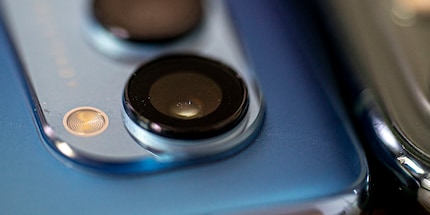
On the flip side, there’s the Qualcomm Snapdragon 765 system on a chip (SoC). Current flagships are equipped with the 800 series – the 865, to be precise. But still: the 765 does 5G. Although the 5G in the Oppo Reno 4 is non-standalone (NSA), i.e. it’s based on 4G LTE, it’s still faster than LTE.
The flip side of the flip side is that the phone is extremely light. 5G platforms still have the habit of being heavy. Manufacturers like to stay below the 200-gram limit. It’s a mystical magic number that probably resulted from the same thought process as «199.90 francs are not 200 francs, so therefore what a steal!» So, they’ve decided to save on battery capacity to make room for the power-guzzling 5G. With a total battery capacity of 4,000 mAh and the NSA platform, the Reno 4 Pro weighs 161 grams without the SIM card. That’s not just light for a 5G phone; it’s very light in general.
Once it emerges out of the whole hardware assembly process, the almost-flagship feels quite nice in your hand. Granted, 161 grams borders «this feels cheap», because a phone really does need to have a certain weight. But I wager this limit lies somewhere around 155 grams, which is just under the weight of the LG V30 from 2017. Mind you, that thing is pretty old, but it was the first phone that made me wonder if it’s too light. The backplate of the Reno 4 has a slightly rough texture to it, which contributes to the phone feeling as nice as it does.
The camera that potentially promises more than it can deliver
Apropos the backplate. That camera bump looks mighty familiar. Where might we know it from? Perhaps from a certain corporation named after a fruit?
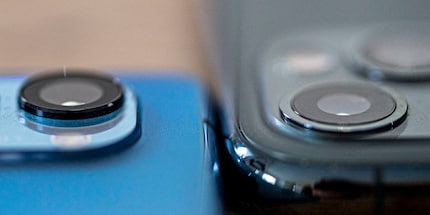
The world is bound to notice that the camera bump on the Oppo Reno 4 is identical to that of the iPhone, minus the camera constellation. There’s the matt backplate with the shiny first-level bump. Then you have the lenses that stick out of the second bump. Oh, Oppo. And you surely thought nobody would notice. Yeah, no.
Underneath the bumps, which are most definitely not at all copied from the iPhone – what a ridiculous thought – there are three cameras. Four, if you count the depth sensor as a camera. Technologically speaking, it is a camera. But it doesn’t take any pictures; it provides telemetry data for the other three cameras to use for image optimisation, both in terms of hardware during the shot, and in terms of AI during post processing.
The other three cameras:
- 48 megapixels, f/1.7 wide-angle lens
- 8 megapixels, f/2.2, ultra wide-angle lens with 119° field of view
- 2 megapixels, f/2.4 macro lens
At face value, that’s somewhere between «pretty ok» and «perfectly standard». But the sensor behind the wide-angle lens is the real innovation, according to Oppo’s PR materials. The Sony IMX708 is supposed to be particularly well suited for shooting in the dark. So, Oppo has equipped the Reno 4 with a night mode. That’s not unusual for photos. But it's unusual for video – there’s loads more data that needs to be processed loads faster. And nobody wants to have to wait for a video to be done processing, be rendered anew and then saved.
In addition, videos filmed in the dark are supposed to boast particularly good stabilisation. «This will even survive your bike test,» they claimed at the event. That’s the test I’ve successfully used to bring every camera stabilisation system to its knees thus far. Because smartphone cameras are optimised for the speed of a pedestrian, possibly a runner. But if you want to know what this type of system is really capable of, you need to use it exactly opposite to the manufacturer’s recommendations – you need to administer a stress test.
The manufacturer’s response is then typically, «But that’s not the actual use case.» Yeah, I know that. That’s exactly why I do it. But Oppo comes right out with the challenge to test it exactly how it’s not meant to be tested.
Well, well. Don’t mind if I do. So, at 11 p.m., I get on the Harley and hope to be back home before the rain hits.
That was the first trip. After I get back to the turning area – where, on a completely unrelated note, a strange white van is parked – I realise that Oppo has gracefully egged its own face. There is, in fact, an ultra night mode for video, but it’s not activated by default. Um, why? You have something that’s, at the very least, supposed to revolutionise videography, and it’s switched off by default? What the heck?
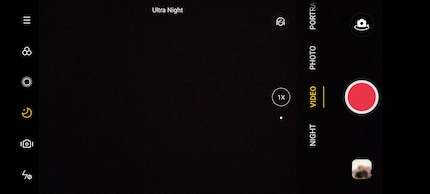
Okay, ultra night video – the little moon in the menu bar – is activated. Same trip again, same hope of staying dry.
Was it worth it? Not really. The big insights are: I take basically the same path through the roundabout on both trips and I got to speed through the night a bit on my motorcycle. But in terms of the video, I could have saved myself the drive. Sure, some of the colours pack a bit more punch, but revolutionary it is not.
On the other hand, the stabilisation is actually impressive. Aside from the light coming from the headlights, there are no points of reference that can be used to stabilise the image. And yet, the image isn’t intolerably shaky by any means. But the sound is an absolute catastrophe, and it has finally convinced me to start testing external microphones for smartphones. I mean, it’s really bad.
When it comes to photography, though, you win with the Oppo Reno 4 Pro. Because in that respect, it’s a flagship. I don't know if you know this, but Oppo has hit the nail on the head with the Find X2 Pro’s night mode – it’s the best available in the current flagship generation. No camera takes night pictures as beautiful as those taken on the Find X2 Pro.
Except the Reno 4 Pro.
Of course, you get the light-blue skies, which I don't like, aesthetically speaking, but I admit are technologically impressive. Or the orange skies, if light pollution is severe. In any case, Oppo could have advertised this and massively impressed everybody with it.
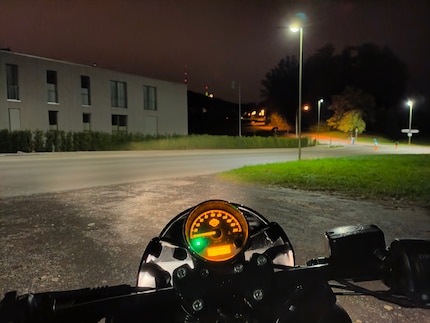
In the glaring digitec-studio backlighting, the camera performs so well that even the spotlight right in front of my face – with its two-metre diameter – can't spoil the picture.
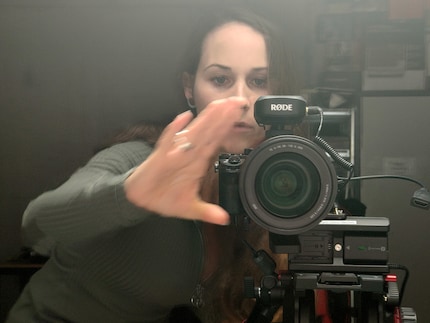
Now that’s flagship. No doubt. So, a general question: Oppo, why aren't you making a big fuss about photo night mode? It's not just good; it's excellent. But no, let’s talk for ages about the mid-range video night mode instead. Um, why?
Or here’s another idea: talk more about the charging technology. Because Oppo has something very clever going on. The battery is, by far, one of the most unattractive elements of a smartphone. Nobody cares what a battery can do or does. Right up until that icon at the top turns red, and the phone suggests that you either switch to power save mode or recharge your phone. So, you want either a big battery or fast charging technology. The Reno 4 Pro has an okay battery with 4,000 mAh; or 2x2000 mAh, to be precise. Because Oppo has built in proprietary VOOC charging, which charges your phone at a «speed of 65 watts». It also only vaguely sounds like a German speaker’s pronunciation of the word «fuck». To prevent the battery from overheating, Oppo split it in two. This allows you to charge the phone from zero to one hundred in about thirty minutes.
Other companies stand to learn a great deal from this technology. But nah. The totally average night mode for video is what counts.
A word about language
Speaking of marketing: Oppo is doing a lot of things in a new way, including language. The Chinese manufacturer is the market leader when it comes to using terms in ways they really shouldn’t be used. So, please forgive this digression and/or appendix.
Oppo speaks of 256 GB of ROM, i.e. internal memory. ROM stands for «Read Only Memory», i.e. «memory, that can only be read». That's a bit silly, given the data you generate – be it an image or a video – has to be stored somewhere. Meaning, you need writable memory. So exactly not ROM. To use the language from the golden age of CD burners: RW, meaning read-write, not ROM.
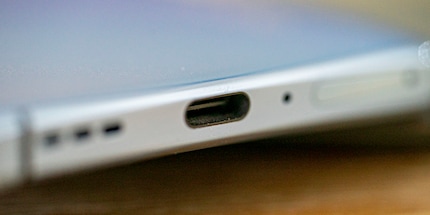
That makes about as much sense as if I were to claim that the Oppo Reno 4 Pro has 256 litres of memory. You know what? Let's do some math. A page with the filler text «Llorem Ipsum» in Word has 566 words or 3815 characters, including spaces. Saved as TXT, this corresponds to 4 KB. This means that in Reno 4 Pro you can save 244,160,000,000 characters. Or 64,000,000 pages. Or 52,631.57895 times the complete series of «Lord of the Rings». The Oppo Reno 4 Pro therefore has 52,631 Lord of the Rings of memory, or to put it more elegantly: 52.6 Gigalords of memory.
As absurd as my Gigalords may seem as a storage unit, they’re still better than ROM.
And then there's the bit about charging speed. Oppo cheekily claims a «charging speed of 65 watts». This is where critics would point out that the watt is not a unit of speed. This may be true, but the watt is still a good indication of charging speed. The watt is a unit of power. So, the problem is not the word «watt», but the descriptor «speed». A «charging power of 65 watts» would make more sense.
Bam. Done. By the way, the Oppo Reno 4 Pro is also available in neon green. Do I think that's cool because it's objectively cool? Or is it because I’ve already had so many black phones that everything un-black is automatically amazing?
Journalist. Author. Hacker. A storyteller searching for boundaries, secrets and taboos – putting the world to paper. Not because I can but because I can’t not.




